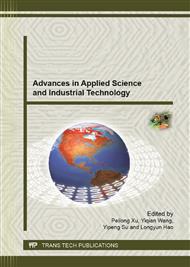[1]
S. Iijima, Nature 354 (1991) 56-58.
Google Scholar
[2]
Andreas Mavrandonakis, George E. Froudakis, Antonis Andriotis and Madhu Menon, Appl. Phys. Lett. 89 (2006) 123126-123128.
DOI: 10.1063/1.2221418
Google Scholar
[3]
Peter Deák, Adam Buruzs, Adam Gali, and Thomas Frauenheim, Phys. Rev. Lett. 96 (2006) 236803-236806.
Google Scholar
[4]
Nicolas Keller, Cuong Pham-Huu, Gabrielle Ehret, Valérie Keller, Marc J. Ledoux, Carbon 41 (2003) 2131-2139.
DOI: 10.1016/s0008-6223(03)00239-2
Google Scholar
[5]
A. Mavrandonakis, George E. Froudakis, M. Schnell, Nano Lett. 3 (2003) 1481-1484.
Google Scholar
[6]
G Alfieri, T Kimoto, Nanotechnology 20 (2009) 285703-285708.
Google Scholar
[7]
Madhu Menon, Ernst Richter, Phys. Rev. B 69 (2004) 115322-115325.
Google Scholar
[8]
C. L. Xu, B. Q. Wei, R. Z. Ma, J. Liang, X. K. Ma and D. H. Wu, Carbon 37 (1999) 855-858.
Google Scholar
[9]
K. M. Kumar, V. Kripeshi and A. A. O. Tay, J. Alloys compd 450 (2008) 229-237.
Google Scholar
[10]
M. R. Piggott, Carbon 27(1989) 657-662.
Google Scholar
[11]
C. C. Poteet and I. W. Hall, Mater. Sci. Eng. A 222 (1997) 35-44.
Google Scholar
[12]
S. Hong and S. Myung, Nature Nanotech 2 (2007) 207-208.
Google Scholar
[13]
Y. Tang, H. cong, R. Zhong and H. M. Cheng, Carbon 42 (2004) 3260-3262.
Google Scholar
[14]
Y. H. wang, Y. N. Li, J. Lu, J. B. Zang and H. Huang, Nanotechnology 17 (2006) 3817-3821.
Google Scholar
[15]
Y. Chen, K. Balani and A. Agarwal, Appl. Phys. Lett 91(2007) 319031-319033.
Google Scholar
[16]
C. F. Deng, D. Z. Wang, X. X. Zhang and Y. X. Ma, Mater. Lett. 61 (2007) 3229-3231.
Google Scholar
[17]
Oksiuta, Zbigniew,JOURNAL OF MATERIALS SCIENCE 48(2013)4801-4805.
Google Scholar
[18]
Nikulin. SA, Rogachev. SO, Khatkevich. VM, Rozhnov. AB, Nechaykina. TA, JOURNAL OF ALLOYS AND COMPOUNDS 524 (2013) 114-116.
DOI: 10.1016/j.jallcom.2013.02.162
Google Scholar
[19]
Tatsumi Ishihara, Masashi Nakasu, Masaki Yoshio, Hiroyasu Nishiguchi, Yusaku Takita, Jounrnal of Power Sources 146 (2005)161-165.
DOI: 10.1016/j.jpowsour.2005.03.110
Google Scholar
[20]
M. zhang, Y.H. Kan, O.J. zang, Z.M. Su, R.S. Wang, Chem. Phys. Lett 379 (2003) 81-86.
Google Scholar
[21]
G. Kresse, J. Hafner, Phys. Rev. B 47 (1993) 558-561.
Google Scholar
[22]
G. Kresse, J. Hafner, Phys. Rev. B 49 (1994) 14251-14269.
Google Scholar
[23]
G. Kresse, J. Furthm€uller, Comput. Mater. Sci. 6 (1996)15-50.
Google Scholar
[24]
V. Milman, B. Winkler, J.A. White, Int. J. Quantum. Chem. 7 7 (2000) 895-910.
Google Scholar
[25]
J.P. Perdew, K. Burke, M. Ernzerhof, Phys. Rev. Lett. 77 (1996) 3865-3868.
Google Scholar
[26]
D. Vanderbilt, Phys. Rev. B 41 (1990) 7892-7895.
Google Scholar
[27]
H.J. Monkhorst, J. D. Pack, Phys. Rev. B (1976) 5188-5192.
Google Scholar
[28]
Vadym V. Kulish, Man-Fai Ng, Oleksandr I. Malyi, Ping Wu, and Zhong Chen, ChemPhysChem 14 (2013) 1161-1167.
Google Scholar


